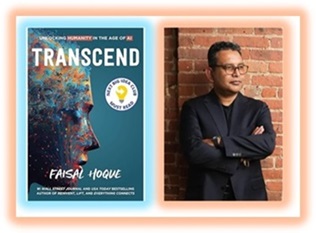Artificial Intelligence (AI) is no longer a speculative frontier—it’s a pervasive force transforming how we live, work, and govern. It is reshaping the public sector, from streamlining citizen services to enhancing national security. On a special edition of The Business of Government Hour, I had the pleasure of interviewing Faisal Hoque, a seasoned entrepreneur, thought leader, and author of TRANSCEND: Unlocking Humanity in the Age of AI. With over 30 years of experience advising Fortune 50 companies and federal agencies like the U.S. Department of Defense and Department of Homeland Security, Hoque brings a unique blend of technological expertise, philosophical acumen, and human-centered leadership to the AI conversation.
Our discussion explored how government leaders can harness AI’s potential to enhance public service while preserving humanity at the heart of governance.
Hoque’s central message is clear: “Humanity is the most important thing.” This ethos, which bookends TRANSCEND, frames AI not as a technological overlord but as a tool to amplify human purpose. Below, I’ll unpack the key insights from our dialogue, distill actionable leadership lessons, and provide practical recommendations for government executives to navigate this AI-driven era responsibly and effectively.
Four Key Leadership Insights from TRANSCEND
AI as a Mirror of Humanity. When I asked Faisal about the central thesis of TRANSCEND, he didn’t hesitate to frame AI as a “technological philosopher’s stone”—a tool with the mythical power to transform and enlighten, built on the vast expanse of human knowledge. It’s an evocative metaphor that stuck with me throughout our conversation. He argued that AI’s ability to tap into our collective intellect offers unprecedented opportunities—whether it’s accelerating cancer research, as he’s personally invested in, or enhancing government service delivery. Yet, he was quick to add a caveat: to wield this power effectively, we must first understand ourselves. “Know thyself,” he said, echoing ancient wisdom, is the starting point for unlocking AI’s potential.
This theme of self-awareness permeated our discussion. Faisal emphasized that AI is a mirror reflecting humanity—its brilliance and its flaws. The data we feed it determines what it gives back, raising ethical questions about bias and purpose. For government leaders, this duality is particularly poignant. How do we ensure AI amplifies our mission to serve citizens rather than distort it? It’s a question I posed to Faisal repeatedly, and his answers consistently circled back to humanity as the anchor.
For government executives, this insight underscores the stakes. AI can streamline service delivery or bolster national security, but without a clear purpose—like serving citizens—it risks amplifying inefficiencies or ethical missteps.
Humanity at the Heart of Transformation: Enhancement, Not Replacement. A core argument in TRANSCEND is that AI should “enhance rather than replace human potential.” Hoque warned against outsourcing critical thinking to machines, noting, “The more we outsource our critical thinking process, the more we surrender and the more we become irrelevant.” He illustrated this with organizational efficiency: automating tasks might reduce staff needs, but leaders must weigh the human impact. “Some people may actually lose their job,” he acknowledged, urging mindfulness in implementation.
In the public sector, where trust and service are paramount, this balance is vital. AI can handle repetitive tasks—like processing benefits claims—but human judgment remains essential for nuanced decisions, such as interpreting veterans’ needs or resolving ethical dilemmas. AI, Faisal argued, should be a partner, not a usurper—a tool for empowerment rather than a disruptor that leaves people behind.
This human-centric approach led us to explore two frameworks Faisal presents in the book.
The OPEN and CARE Frameworks. Hoque introduces these frameworks to guide AI adoption: OPEN (Outline, Partner, Experiment, Navigate) and CARE (Catastrophize, Assess, Regulate, Exit). These tools, rooted in his transformation expertise, offer a pragmatic yet ethical approach. “Open is because you have to be open to opportunities,” he explained, while “care about humanity to govern it” drives the CARE model.
- OPEN: This framework encourages leaders to outline goals, partner with AI technologies, experiment with solutions, and navigate outcomes. Hoque highlighted its simplicity: “It’s a very logical, but also very simplistic and pragmatic way of looking at it so that anybody can put arms around it.”
- CARE: Focused on risk management, CARE prompts leaders to imagine catastrophic scenarios, assess risks, regulate usage, and plan exits. Hoque cited a hypothetical government example: using AI to declassify documents could lead to “hallucinations” or leaks, necessitating a “kill switch.”
For government agencies, these frameworks address both innovation and accountability—key tensions in public sector AI adoption.
Resilience, Ethics, and the Future of Work. Our conversation also delved into the qualities government leaders need in an AI-driven world: resilience and adaptability. Faisal stressed that cultivating these traits starts with a culture of continuous learning—not just of technical tools, but of the human behaviors and organizational dynamics AI affects. “Leaders need to become futurists,” he told me, envisioning a workforce where AI is an active team member, not a passive system. This shift, he warned, requires rethinking how we allocate workloads between human and synthetic resources—a challenge I suspect many agency heads will recognize.
Ethics emerged as another critical thread. Faisal’s examples hit home: a medical AI skewed by age-biased data misdiagnosing a young patient, or a hiring algorithm favoring one region over another due to uneven data sets. These scenarios underscore the stakes for government, where national security, citizen privacy, and geopolitical risks amplify AI’s ethical dilemmas. He advocated for a three-pronged approach—legal frameworks, organizational ethics, and individual responsibility—to ensure AI serves the public good without eroding trust.
Looking ahead, Faisal painted a dual picture of AI’s impact on work. On one hand, it promises breakthroughs—faster research, better healthcare, stronger security. On the other, it threatens displacement, with 30-70% of jobs potentially automated in the coming years. “When people don’t have work, they become destructive,” he cautioned, invoking Maslow’s hierarchy to question what happens when basic needs are met but purpose fades. It’s a sobering challenge for government leaders tasked with maintaining societal stability.
For government, these challenges amplify. National security, citizen trust, and geopolitical risks elevate the need for ethical guardrails beyond what’s required in the private sector.
Leadership Lessons for Government Executives
Our conversation distilled several lessons for public sector leaders:
Anchor AI in Purpose. Hoque’s insistence on “why” over “how” reminds leaders to tether AI to their agency’s mission. Whether it’s enhancing public safety or improving healthcare access, purpose must guide deployment.
Balance Empowerment and Oversight. AI’s role as an enhancer, not a replacement, requires leaders to empower staff with technology while retaining human oversight. This preserves trust and accountability—non-negotiables in government.
Foster Resilience Through Learning. “It all begins with a non-stop learning appetite,” Hoque said. Cultivating a culture of adaptability prepares agencies for AI’s active role as a “team member,” not just a passive tool.
Prioritize Ethics in Innovation. The CARE framework’s focus on risk underscores the ethical tightrope government leaders walk. Innovation must coexist with safeguards against bias, privacy breaches, and unintended consequences.
Invest in Critical Thinking. Hoque’s vision of future skills—centered on “the ability to ask the right question”—shifts training from technical mastery to soft skills like empathy and leadership, vital for navigating AI’s complexities.
Putting TRANSCEND into Practice
So, how can government leaders apply these insights? Based on our discussion, here are some recommendations:
- Pilot with OPEN: Use the OPEN framework to test AI solutions—say, predictive analytics for disaster response. Outline possibilities, partner with secure AI platforms, experiment in controlled settings, and navigate to scalable wins.
- Govern with CARE: Before deploying AI, identify risks (e.g., data leaks at the VA), assess their roots (e.g., insecure architecture), regulate with policies like zero-trust security, and plan exits for missteps. Faisal’s declassification example—AI misjudging sensitive documents—illustrates the stakes.
- Foster a Learning Culture: Launch AI literacy programs alongside training in critical thinking and emotional intelligence. Pioneer an AI academy to prepare staff for this shift.
- Strengthen Infrastructure: Prioritize data readiness—privacy, security, interoperability. The SSA could modernize systems to use AI for benefits processing while protecting citizen data.
- Engage Ethically: Partner with lawmakers and experts to regulate AI, addressing deep fakes, IP rights, and equity. Faisal’s talks with senators highlight the need for this dialogue.
- Redefine Skills: Shift training to purpose-driven competencies. At the VA, staff could use AI for personalized care while retaining human oversight, asking “why” and “how” to add value.
Conclusion
Faisal Hoque’s TRANSCEND: Unlocking Humanity in the Age of AI is a clarion call for leaders to place humanity at the heart of technological transformation. For government executives, the book offers a roadmap to harness AI’s potential responsibility, enhancing service delivery, securing national interests, and empowering the workforce—while avoiding pitfalls like bias, displacement, and loss of purpose.
By adopting Hoque’s “OPEN and CARE” frameworks, leaders can navigate AI’s opportunities and dangers with clarity and purpose. The recommendations outlined—mission alignment, transparent communication, risk management, collaboration, leadership training, workforce upskilling, bias mitigation, and transition planning—provide a roadmap for implementation. As Hoque concluded, “Do whatever you want to do to protect that humanity, because otherwise, what’s the point of all this?” For public sector leaders, this is not just a lesson but a mandate to lead with focus, foresight, and a commitment to the public good in the age of AI.





